Baochang Zhang
A Review of Recent Advances of Binary Neural Networks for Edge Computing
Nov 24, 2020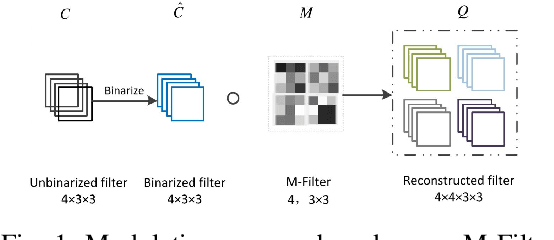

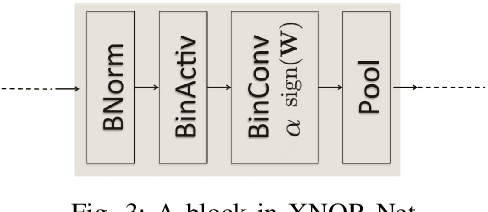

Abstract:Edge computing is promising to become one of the next hottest topics in artificial intelligence because it benefits various evolving domains such as real-time unmanned aerial systems, industrial applications, and the demand for privacy protection. This paper reviews recent advances on binary neural network (BNN) and 1-bit CNN technologies that are well suitable for front-end, edge-based computing. We introduce and summarize existing work and classify them based on gradient approximation, quantization, architecture, loss functions, optimization method, and binary neural architecture search. We also introduce applications in the areas of computer vision and speech recognition and discuss future applications for edge computing.
PAMS: Quantized Super-Resolution via Parameterized Max Scale
Nov 09, 2020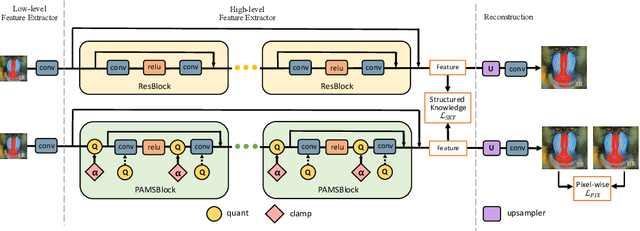

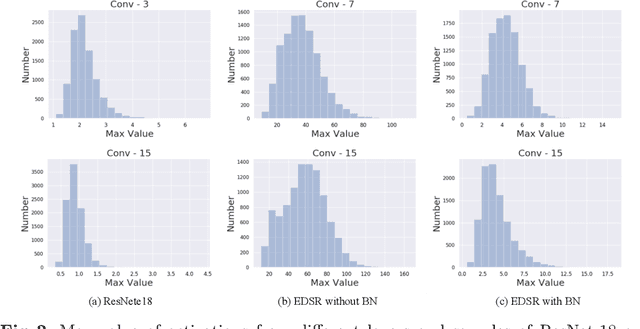

Abstract:Deep convolutional neural networks (DCNNs) have shown dominant performance in the task of super-resolution (SR). However, their heavy memory cost and computation overhead significantly restrict their practical deployments on resource-limited devices, which mainly arise from the floating-point storage and operations between weights and activations. Although previous endeavors mainly resort to fixed-point operations, quantizing both weights and activations with fixed coding lengths may cause significant performance drop, especially on low bits. Specifically, most state-of-the-art SR models without batch normalization have a large dynamic quantization range, which also serves as another cause of performance drop. To address these two issues, we propose a new quantization scheme termed PArameterized Max Scale (PAMS), which applies the trainable truncated parameter to explore the upper bound of the quantization range adaptively. Finally, a structured knowledge transfer (SKT) loss is introduced to fine-tune the quantized network. Extensive experiments demonstrate that the proposed PAMS scheme can well compress and accelerate the existing SR models such as EDSR and RDN. Notably, 8-bit PAMS-EDSR improves PSNR on Set5 benchmark from 32.095dB to 32.124dB with 2.42$\times$ compression ratio, which achieves a new state-of-the-art.
Rotated Binary Neural Network
Oct 22, 2020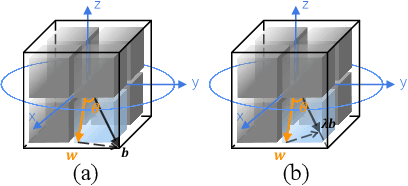

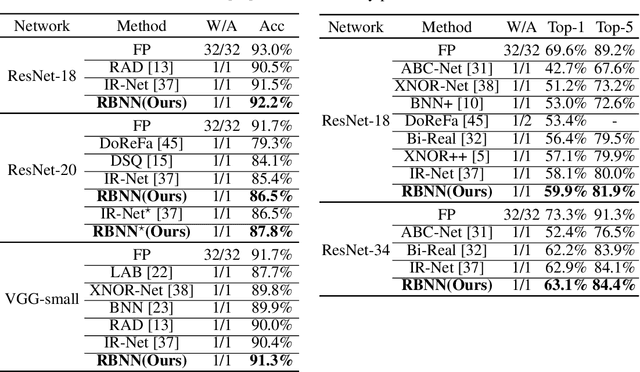
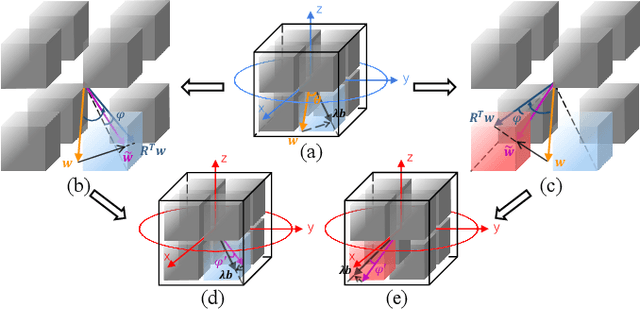
Abstract:Binary Neural Network (BNN) shows its predominance in reducing the complexity of deep neural networks. However, it suffers severe performance degradation. One of the major impediments is the large quantization error between the full-precision weight vector and its binary vector. Previous works focus on compensating for the norm gap while leaving the angular bias hardly touched. In this paper, for the first time, we explore the influence of angular bias on the quantization error and then introduce a Rotated Binary Neural Network (RBNN), which considers the angle alignment between the full-precision weight vector and its binarized version. At the beginning of each training epoch, we propose to rotate the full-precision weight vector to its binary vector to reduce the angular bias. To avoid the high complexity of learning a large rotation matrix, we further introduce a bi-rotation formulation that learns two smaller rotation matrices. In the training stage, we devise an adjustable rotated weight vector for binarization to escape the potential local optimum. Our rotation leads to around 50% weight flips which maximize the information gain. Finally, we propose a training-aware approximation of the sign function for the gradient backward. Experiments on CIFAR-10 and ImageNet demonstrate the superiorities of RBNN over many state-of-the-arts. Our source code, experimental settings, training logs and binary models are available at https://github.com/lmbxmu/RBNN.
The 1st Tiny Object Detection Challenge:Methods and Results
Oct 06, 2020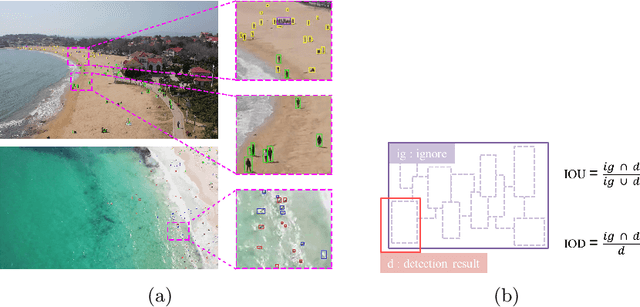
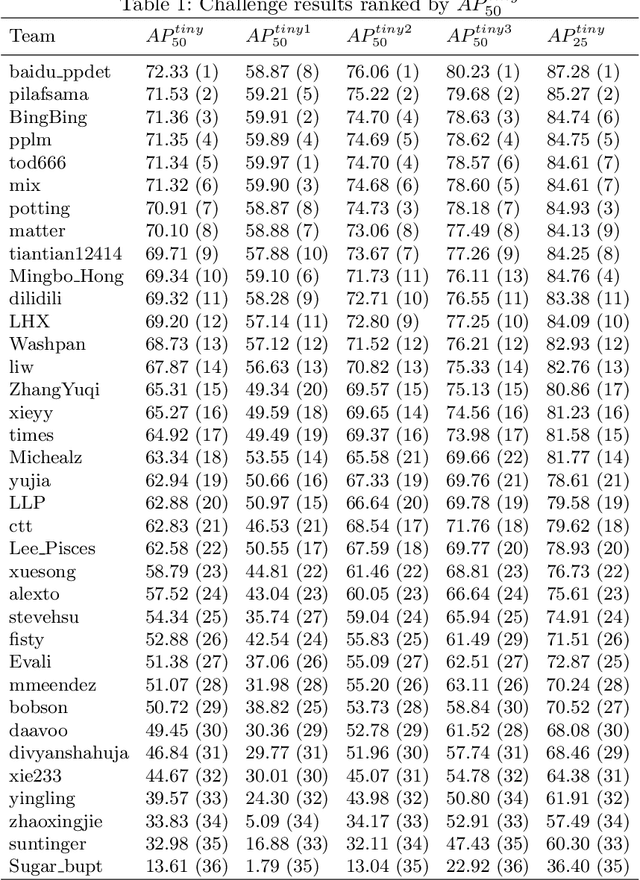


Abstract:The 1st Tiny Object Detection (TOD) Challenge aims to encourage research in developing novel and accurate methods for tiny object detection in images which have wide views, with a current focus on tiny person detection. The TinyPerson dataset was used for the TOD Challenge and is publicly released. It has 1610 images and 72651 box-levelannotations. Around 36 participating teams from the globe competed inthe 1st TOD Challenge. In this paper, we provide a brief summary of the1st TOD Challenge including brief introductions to the top three methods.The submission leaderboard will be reopened for researchers that areinterested in the TOD challenge. The benchmark dataset and other information can be found at: https://github.com/ucas-vg/TinyBenchmark.
Binarized Neural Architecture Search for Efficient Object Recognition
Sep 08, 2020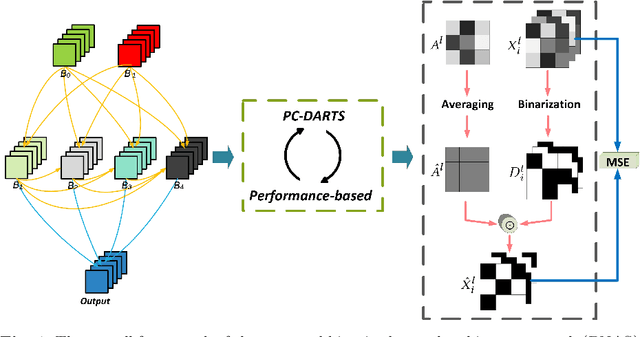

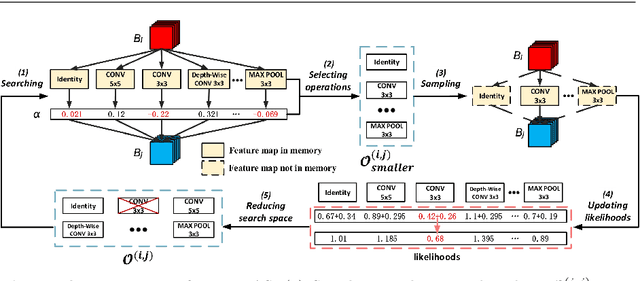
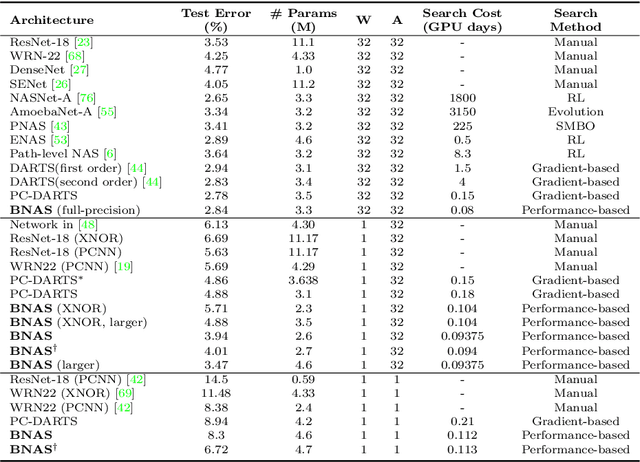
Abstract:Traditional neural architecture search (NAS) has a significant impact in computer vision by automatically designing network architectures for various tasks. In this paper, binarized neural architecture search (BNAS), with a search space of binarized convolutions, is introduced to produce extremely compressed models to reduce huge computational cost on embedded devices for edge computing. The BNAS calculation is more challenging than NAS due to the learning inefficiency caused by optimization requirements and the huge architecture space, and the performance loss when handling the wild data in various computing applications. To address these issues, we introduce operation space reduction and channel sampling into BNAS to significantly reduce the cost of searching. This is accomplished through a performance-based strategy that is robust to wild data, which is further used to abandon less potential operations. Furthermore, we introduce the Upper Confidence Bound (UCB) to solve 1-bit BNAS. Two optimization methods for binarized neural networks are used to validate the effectiveness of our BNAS. Extensive experiments demonstrate that the proposed BNAS achieves a comparable performance to NAS on both CIFAR and ImageNet databases. An accuracy of $96.53\%$ vs. $97.22\%$ is achieved on the CIFAR-10 dataset, but with a significantly compressed model, and a $40\%$ faster search than the state-of-the-art PC-DARTS. On the wild face recognition task, our binarized models achieve a performance similar to their corresponding full-precision models.
Anti-Bandit Neural Architecture Search for Model Defense
Aug 05, 2020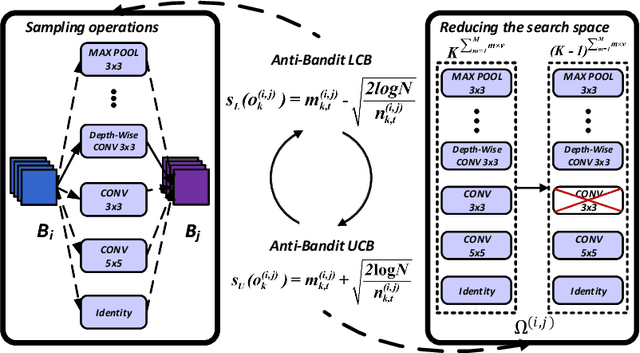



Abstract:Deep convolutional neural networks (DCNNs) have dominated as the best performers in machine learning, but can be challenged by adversarial attacks. In this paper, we defend against adversarial attacks using neural architecture search (NAS) which is based on a comprehensive search of denoising blocks, weight-free operations, Gabor filters and convolutions. The resulting anti-bandit NAS (ABanditNAS) incorporates a new operation evaluation measure and search process based on the lower and upper confidence bounds (LCB and UCB). Unlike the conventional bandit algorithm using UCB for evaluation only, we use UCB to abandon arms for search efficiency and LCB for a fair competition between arms. Extensive experiments demonstrate that ABanditNAS is faster than other NAS methods, while achieving an $8.73\%$ improvement over prior arts on CIFAR-10 under PGD-$7$.
iffDetector: Inference-aware Feature Filtering for Object Detection
Jun 23, 2020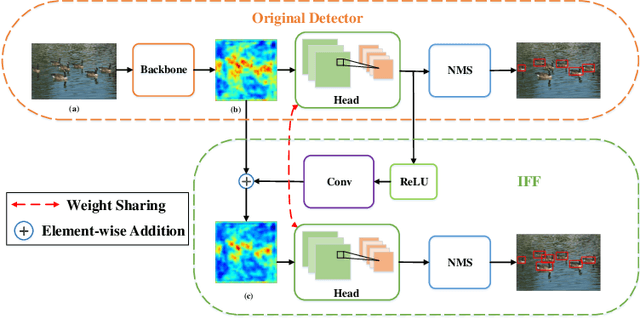

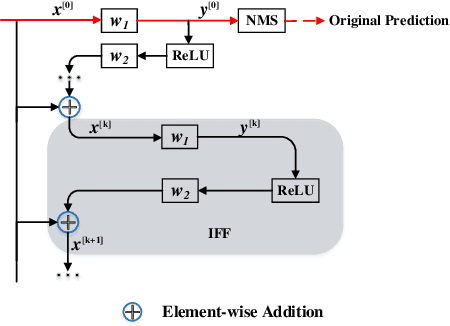

Abstract:Modern CNN-based object detectors focus on feature configuration during training but often ignore feature optimization during inference. In this paper, we propose a new feature optimization approach to enhance features and suppress background noise in both the training and inference stages. We introduce a generic Inference-aware Feature Filtering (IFF) module that can easily be combined with modern detectors, resulting in our iffDetector. Unlike conventional open-loop feature calculation approaches without feedback, the IFF module performs closed-loop optimization by leveraging high-level semantics to enhance the convolutional features. By applying Fourier transform analysis, we demonstrate that the IFF module acts as a negative feedback that theoretically guarantees the stability of feature learning. IFF can be fused with CNN-based object detectors in a plug-and-play manner with negligible computational cost overhead. Experiments on the PASCAL VOC and MS COCO datasets demonstrate that our iffDetector consistently outperforms state-of-the-art methods by significant margins\footnote{The test code and model are anonymously available in https://github.com/anonymous2020new/iffDetector }.
Cogradient Descent for Bilinear Optimization
Jun 16, 2020



Abstract:Conventional learning methods simplify the bilinear model by regarding two intrinsically coupled factors independently, which degrades the optimization procedure. One reason lies in the insufficient training due to the asynchronous gradient descent, which results in vanishing gradients for the coupled variables. In this paper, we introduce a Cogradient Descent algorithm (CoGD) to address the bilinear problem, based on a theoretical framework to coordinate the gradient of hidden variables via a projection function. We solve one variable by considering its coupling relationship with the other, leading to a synchronous gradient descent to facilitate the optimization procedure. Our algorithm is applied to solve problems with one variable under the sparsity constraint, which is widely used in the learning paradigm. We validate our CoGD considering an extensive set of applications including image reconstruction, inpainting, and network pruning. Experiments show that it improves the state-of-the-art by a significant margin.
CP-NAS: Child-Parent Neural Architecture Search for Binary Neural Networks
May 17, 2020

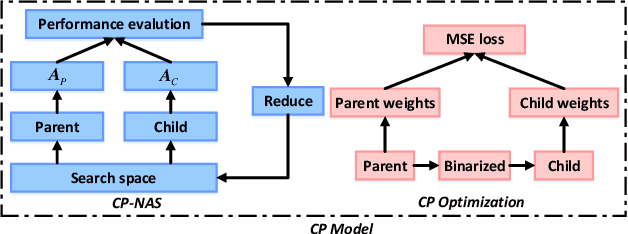

Abstract:Neural architecture search (NAS) proves to be among the best approaches for many tasks by generating an application-adaptive neural architecture, which is still challenged by high computational cost and memory consumption. At the same time, 1-bit convolutional neural networks (CNNs) with binarized weights and activations show their potential for resource-limited embedded devices. One natural approach is to use 1-bit CNNs to reduce the computation and memory cost of NAS by taking advantage of the strengths of each in a unified framework. To this end, a Child-Parent (CP) model is introduced to a differentiable NAS to search the binarized architecture (Child) under the supervision of a full-precision model (Parent). In the search stage, the Child-Parent model uses an indicator generated by the child and parent model accuracy to evaluate the performance and abandon operations with less potential. In the training stage, a kernel-level CP loss is introduced to optimize the binarized network. Extensive experiments demonstrate that the proposed CP-NAS achieves a comparable accuracy with traditional NAS on both the CIFAR and ImageNet databases. It achieves the accuracy of $95.27\%$ on CIFAR-10, $64.3\%$ on ImageNet with binarized weights and activations, and a $30\%$ faster search than prior arts.
HRank: Filter Pruning using High-Rank Feature Map
Mar 16, 2020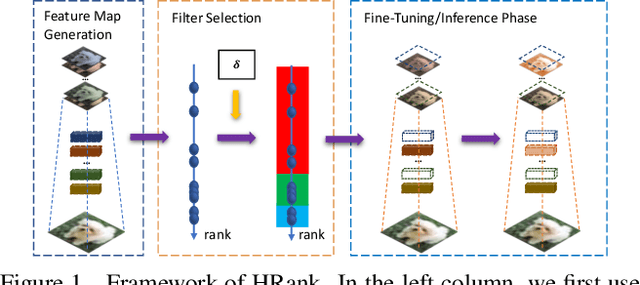
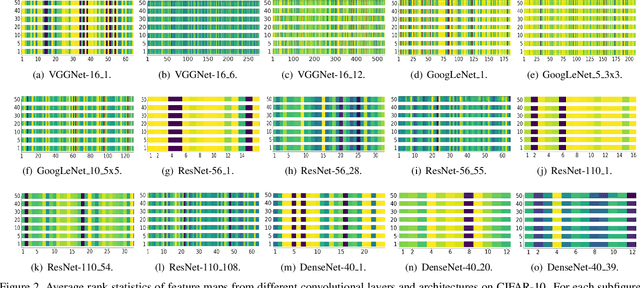
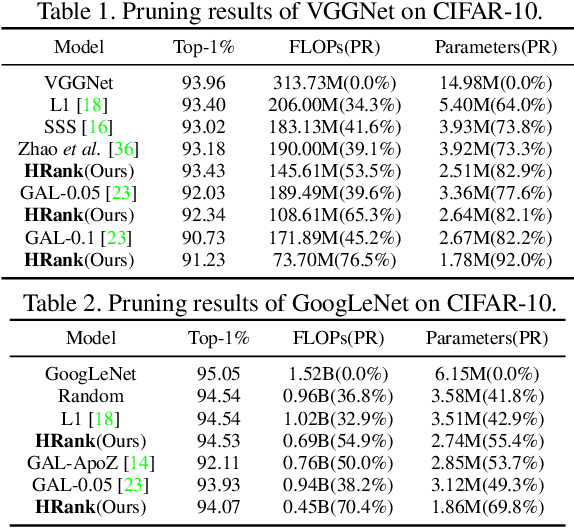

Abstract:Neural network pruning offers a promising prospect to facilitate deploying deep neural networks on resource-limited devices. However, existing methods are still challenged by the training inefficiency and labor cost in pruning designs, due to missing theoretical guidance of non-salient network components. In this paper, we propose a novel filter pruning method by exploring the High Rank of feature maps (HRank). Our HRank is inspired by the discovery that the average rank of multiple feature maps generated by a single filter is always the same, regardless of the number of image batches CNNs receive. Based on HRank, we develop a method that is mathematically formulated to prune filters with low-rank feature maps. The principle behind our pruning is that low-rank feature maps contain less information, and thus pruned results can be easily reproduced. Besides, we experimentally show that weights with high-rank feature maps contain more important information, such that even when a portion is not updated, very little damage would be done to the model performance. Without introducing any additional constraints, HRank leads to significant improvements over the state-of-the-arts in terms of FLOPs and parameters reduction, with similar accuracies. For example, with ResNet-110, we achieve a 58.2%-FLOPs reduction by removing 59.2% of the parameters, with only a small loss of 0.14% in top-1 accuracy on CIFAR-10. With Res-50, we achieve a 43.8%-FLOPs reduction by removing 36.7% of the parameters, with only a loss of 1.17% in the top-1 accuracy on ImageNet. The codes can be available at https://github.com/lmbxmu/HRank.
 Add to Chrome
Add to Chrome Add to Firefox
Add to Firefox Add to Edge
Add to Edge